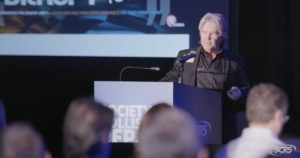
See DEKRA, Material Sciences, SEMA talk vehicle tech in new SCRS OEM Summit video
By onAssociations | Business Practices | Education | Market Trends | Repair Operations | Technology
A SEMA perspective on vehicle technology, a look at Material Sciences Corporation’s “Smart Steel,” and a DEKRA warning on the limits of visual inspection are now all available for collision repairers to watch at their leisure.
The presentations were part of the first session of the Society of Collision Repair Specialists’ 2019 OEM Collision Repair Technology Summit, the headliner event of SCRS’ Repairer Driven Education series. SCRS posted free video coverage of the talks during “From Substrate to Surface – Emerging Trends in Automotive Technology” on its YouTube channel March 19.
If your shop has kept employees on the payroll but has suffered lower demand due to the COVID-19 response, why not use the slow hours to focus on staff training and education? In addition to the “Emerging Trends” video, SCRS over the past month has posted four video recaps of RDE classes and footage from an OEM summit session focusing on repair procedures. Check them out on the SCRScollision YouTube page, and consider subscribing to the channel as well.
Here’s some highlights from the “Emerging Trends” session video:
01:32: SEMA vehicle technology Vice President John Waraniak begins his presentation.
02:45: Five megatrends affecting the industry — including climate change. It’s irrelevant whether cars cause it, Warniak argued. “It matters to the millennials,” he said. “People that are our future.”
07:31: Cars “stopped going faster” in Indianapolis in 1993, Warniak said. Now, it’s time to make them smarter.
08:07: The “very polarizing” Indianapolis autonomous challenge.
12:00: SAE standards to commonize names for technology. “We need to standardize that,” Warniak said.
14:43: The industry collaboration on ADAS, including associations like SCRS and SEMA.
21:44: The “tremendous business opportunities” available to the summit audience as cars get smarter.
24:29: Material Sciences Corporation Chief Technology Officer Matt Murphy starts his presentation.
25:00: 50-60 percent of automotive suppliers have changed to focus on lightweighting or efficiency, and those that haven’t might have “limited scope” of opportunities.
26:01: Auto industry is risk averse, but willing to pay “premium” to meet challenges like government regulations.
27:14: About the Material Sciences Corporation and what Murphy calls its “coil in, coil out” manufacturing focus.
28:11: “Smart steel,” a laminated steel weighing 30-40 percent less but carrying similar bendability and the ability to be spot-welded.
29:01: “Quiet steel” and “quiet aluminum,” which remove the need for dampening products but can be stamped like regular metals.
33:17: Enforcement of environmental standards and the “very expensive penalty” for missing them: $5.50 per 0.1 mpg over the standard per vehicle.
34:09: Environmental credits for OEMs which can beat the environmental standards — and how these can be sold or traded to OEMs who can’t.
36:00: What MSC calls “mass creep”: Cars weigh more despite lightweighting advances.
37:50: How OEMs are offsetting fuel economy targets — including $36 billion to hit the 2025 emissions target.
39:30: Comparing a 3,600-pound 1977 Pontiac Bandit to a vehicle today.
42:42: The 2015 aluminum Ford F-150 and the challenges it presented.
45:50: How Material Sciences Corporation used “quiet steel” to reduce noise, vibration and harshness on the aluminum F-150.
49:56: How a 1,500-megapascal bumper beam today is “roughly seven times stronger than anything” on a 1970s Trans Am.
50:31: Material Sciences Corporation’s “smart steel” in the 2020 Ford Escape.
54:26: DEKRA Services managing director Christian Ruecker’s presentation.
57:15 Curiosity about crashes involving vehicles without significant technology.
57:36: A DEKRA test involving a 2009 Mercedes C200 CDI T-Model crashed at 6.1 mph into a trailer hitch mounted on an unbraked 2,932-pound barrier on wheels. It looks minor from the outside, but significant, structural damage exists beneath the surface of the 10-year-old vehicle.
1:02:24: That minor repair is actually thousands of dollars in damage, even at a U.S. labor rate of $50. The consumer “freaks out” when they see it.
1:04:04: Disassembly is “most crucial” part of repair process.
More information:
“SCRS OEM Summit: From Substrate to Surface – Emerging Trends in Automotive Technology”
Society of Collision Repair Specialists YouTube channel, March 19, 2020
Featured image: SEMA vehicle technology Vice President John Waraniak speaks at the 2019 SCRS OEM Collision Repair Technology Summit. (Screenshot from SCRS video on YouTube)
